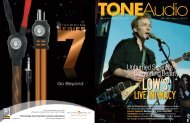You also want an ePaper? Increase the reach of your titles
YUMPU automatically turns print PDFs into web optimized ePapers that Google loves.
REVIEW<br />
REVIEW<br />
After an hour of scooting the<br />
Octaves around my listening room—<br />
which is 17 feet deep and 20 feet<br />
wide, with a 10.5-foot ceiling—I find<br />
the ideal placement to be about 4<br />
feet from the front wall with a slight<br />
toe-in, thereby twisting the side-firing<br />
woofers slightly toward the rear of the<br />
room.<br />
Sound and Performance<br />
My reference speakers, the Piega<br />
P-10s, are larger than the Octave and<br />
in their day, the Piegas cost twice as<br />
much as the Octaves, so it’s not a<br />
fair comparison, though the Octaves<br />
offer some similarities in terms of<br />
sonic signature. They reproduce a<br />
little less detail and ambience than<br />
the Piegas, though they absolutely<br />
hold their own, filling the room with<br />
wonderful music. The Octaves create<br />
the illusion of sitting a few rows<br />
back in an auditorium during a live<br />
performance. From that perspective,<br />
a bit of lost detail is natural.<br />
Morel says the Octave’s frequency<br />
response covers the 20-Hzto-20-kHz<br />
range of human hearing<br />
and extends to 22 kHz. The speakers<br />
offer a high level of neutrality, more<br />
so than the Virgos, which have a<br />
slightly warm character. Considering<br />
the Octaves modest cabinet size, the<br />
amount of low-frequency information<br />
they portray is impressive. The upper<br />
and mid-bass regions remain tuneful,<br />
tight, and well defined. Frequencysweep<br />
tracks verify the speakers<br />
can produce very low frequencies,<br />
though they roll off below 40 Hz in<br />
my room, despite experimentation<br />
with speaker placement. The Octaves<br />
do work magic, but at some<br />
point the rules of physics take over.<br />
There’s only so much stomach-tingling<br />
oomph that a small enclosure can<br />
muster.<br />
The Octaves don’t offer the level of<br />
bass tangibility I’m accustomed to with<br />
my reference speakers. For example,<br />
passages on Pitch Black’s “Ape to<br />
Angel” leave me longing for more heft.<br />
Still, I remain amazed at what the<br />
Octaves can produce, given sufficient<br />
amplifier power. The touch of low-bass<br />
shyness I experience may not be as<br />
apparent in a smaller room.<br />
The Octaves do a great job of<br />
high-frequency extension without tipping<br />
toward an edge of stridency or<br />
etch. They deliver plenty of detail while<br />
maintaining the music’s natural sound:<br />
accurate male and female vocals;<br />
cymbals retain their shimmer; saxophones<br />
and clarinets are rendered with<br />
appropriate woodiness; and on good<br />
acoustic guitar recordings, it’s easy to<br />
discern the difference between nylon<br />
and metal strings.<br />
Soundstage and Dimensionality<br />
The Octave 6 Limited speakers have<br />
the ability to cast sound in all directions,<br />
while drawing no particular<br />
attention to the physical location of the<br />
speakers. Music drifts organically and<br />
effortlessly between and beyond the<br />
speaker boundaries, immersing the<br />
listener in sound. Everyone’s listening<br />
space provides different benefits and<br />
challenges. In my room, the perceived<br />
depth of the soundstage behind the<br />
speakers is not quite as dramatic as<br />
some speakers I have encountered.<br />
However, the left, right, and vertical<br />
sonic extension rivals that of some of<br />
the best speakers I’ve heard in this<br />
space. (coninued)<br />
202 TONE AUDIO NO.64<br />
July 2014 203




